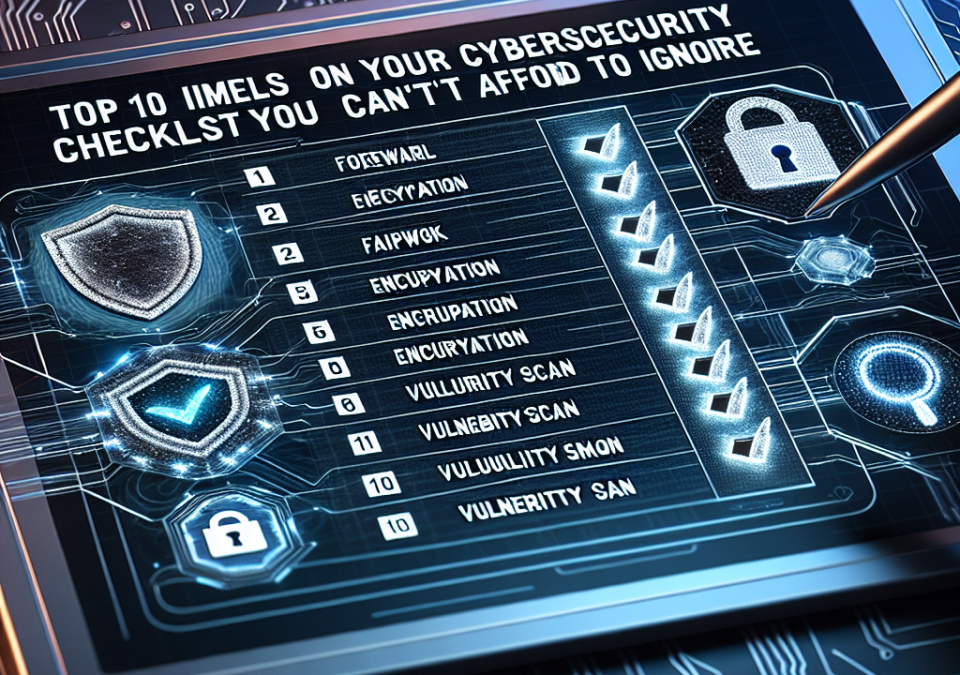
Breaking Down the Complexities of Security Compliance: A Step-by-Step Approach
July 16, 2025
Feel free to modify these as needed to better fit your target audience!
July 17, 2025
In today’s increasingly digital landscape, cybersecurity compliance is no longer just a luxury—it’s a necessity. With data breaches becoming more prevalent and regulations tightening, ensuring that your organization is compliant with cybersecurity standards is critical. Here’s a checklist of the top 10 items you can’t afford to overlook when it comes to cybersecurity compliance.
1. Risk Assessment
Understanding the risks your organization faces is the first step to achieving cybersecurity compliance. Conduct regular risk assessments to identify potential threats, vulnerabilities, and impacts to your assets. This proactive approach enables you to prioritize resources and protect sensitive information effectively.
2. Data Protection Policies
Create and implement comprehensive data protection policies. These should cover data classification, handling, storage, and transmission. Policies must also define how data is collected, processed, shared, and disposed of, ensuring compliance with relevant regulations such as GDPR, HIPAA, or PCI DSS.
3. Access Control Measures
Limit access to sensitive information to only those individuals who require it to perform their job functions. Implement multi-factor authentication, role-based access control, and regular reviews of user permissions to mitigate the risk of unauthorized access.
4. Regular Security Training
Employee awareness and training is a cornerstone of effective cybersecurity compliance. Conduct regular training sessions to educate staff on the evolving threat landscape, phishing tactics, and best practices for securing sensitive data. This can significantly reduce human errors that lead to breaches.
5. Incident Response Plan
Having a well-defined incident response plan is vital for organizations to quickly contain, mitigate, and recover from cyber incidents. Your plan should outline protocols for detecting incidents, notifying stakeholders, investigating breaches, and reporting to regulatory bodies as needed.
6. Network Security Measures
Deploy firewalls, intrusion detection systems, and antivirus software to strengthen your network’s defenses. Regularly update your systems and software to patch vulnerabilities and implement a robust monitoring strategy to detect suspicious activities promptly.
7. Vendor Risk Management
Third-party vendors can pose significant risks to your organization’s cybersecurity. Evaluate the cybersecurity practices of any partner or vendor accessing your data, and ensure they adhere to your compliance standards. Contracts should include clauses that hold vendors accountable for their cybersecurity practices.
8. Regular Audits and Assessments
Regular audits are essential to assess your compliance with internal policies and external regulations. Conducting periodic security assessments helps identify gaps and weaknesses in your cybersecurity posture, allowing you to rectify issues before they become critical.
9. Backup and Recovery Solutions
Implement a robust backup strategy to ensure that your organization can quickly recover from data loss due to cyber incidents, natural disasters, or hardware failures. Test your backup and recovery processes regularly to confirm they work as intended and meet business continuity requirements.
10. Policy Compliance Monitoring
Establish a continuous monitoring framework to ensure adherence to cybersecurity policies and regulatory requirements. Utilize security information and event management (SIEM) tools to streamline compliance monitoring and generate reports that demonstrate your organization’s commitment to cybersecurity.
Conclusion
Cybersecurity compliance is a dynamic and ongoing process that requires vigilance and adaptability. By incorporating these ten essential items into your compliance checklist, your organization will be better equipped to protect sensitive data, maintain trust with stakeholders, and avoid costly penalties associated with non-compliance. Prioritizing these elements is crucial for long-term success in an increasingly complex digital environment.







